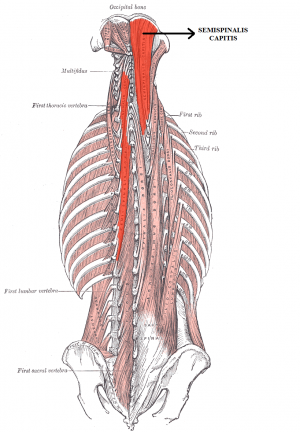Description
The posterior muscles of the neck are divided into four layers. The semispinalis capitis and cervicis muscles lie within the third layer[1]. The semispinalis capitis is a long slender muscle which provided a long moment arm to provide efficient extension.
Origin
The muscle originates on the articular processes of the C 5, 6, 7 and 8 as well as the transverse processes of T 1, 2 ,3 ,4 ,5 and 6.
Insertion
The semispinalis capitis attaches onto the occiput inbetween the superior and inferior nuchal line.
Nerve Supply
Greater occipital nerve, which additionally innervates the scalp[2].
Blood Supply
Descending branches of the occipital artery and the superior intercostal artery, via the dorsal rami of the upper two posterior intercostal arteries [3]
Action
- Acting bilaterally : Extension of the head and neck.
- Acting unilaterally : Rotation of head and neck to opposite side
Function
During bilateral contraction this muscle is considered as a prime mover for dynamically maintaining the cervical lordosis[4]. It is also considered as one of the main factors in maintaining the balance of the head on the neck[5]
References
- ↑ Rezasoltani. A. Kallinen. M . Mälkiä. M. Vihko. V. Neck semispinalis capitis muscle size in sitting and prone positions measured by real-timefckLRultrasonography. Clinical Rehabilitation 1998; 12: 36–44.
- ↑ Natsis K, Baraliakos X, Appell HJ, Tsikaras P, Gigis I, Koebke J. The course of the greater occipital nerve in the suboccipital region: a proposal for setting landmarks for local anesthesia in patients with occipital neuralgia. Clinical Anatomy. 2006 May;19(4):332-6.
- ↑ ↑ Porterfield JA, DeRosa C. Mechanical neck pain,fckLRperspective in functional anatomy. Philadelphia: WB Saunders, 1995.
- ↑ Sinclair D. Functional anatomy, fifth edition.fckLRLondon: B.S. Publication, 1975

